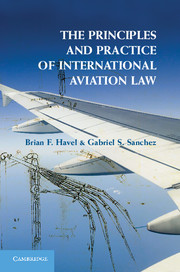Book contents
- Frontmatter
- Contents
- Preface
- Acknowledgments
- Table of Abbreviations and Acronyms
- 1 What is International Aviation Law?
- 2 The Foundations of Public International Aviation Law
- 3 The International Law Regime for Trade in Air Services
- 4 The International Law Regime for Airline Investment and Global Alliances
- 5 The International Law Regime for Aviation Safety and Security
- 6 The International Law Regime for Aviation and the Environment
- 7 The International Law Regime for Air Carrier Liability and Surface Damage
- 8 The International Law Regime for Aircraft Financing and Aircraft Nationality
- Afterword
- Select Bibliography
- Table of Authorities
- Index
- References
3 - The International Law Regime for Trade in Air Services
Published online by Cambridge University Press: 05 June 2014
- Frontmatter
- Contents
- Preface
- Acknowledgments
- Table of Abbreviations and Acronyms
- 1 What is International Aviation Law?
- 2 The Foundations of Public International Aviation Law
- 3 The International Law Regime for Trade in Air Services
- 4 The International Law Regime for Airline Investment and Global Alliances
- 5 The International Law Regime for Aviation Safety and Security
- 6 The International Law Regime for Aviation and the Environment
- 7 The International Law Regime for Air Carrier Liability and Surface Damage
- 8 The International Law Regime for Aircraft Financing and Aircraft Nationality
- Afterword
- Select Bibliography
- Table of Authorities
- Index
- References
Summary
Parallel Frameworks:
As will now be clear, there are parallel frameworks that organize international air services. One is the product of the Chicago Convention and focuses primarily on setting the terms of international technical cooperation and harmonization. The other is a much more specific economic system that is based on bilateral exchange where two States negotiate an air services agreement (ASA) that grants each party’s airlines the privilege to carry passengers, cargo, or a combination of both to points to, from, over, or beyond their respective territories. These market access privileges (commonly referred to as “traffic rights”) have historically been subject to a number of protectionist conditions, including, inter alia, caps on the number of flights flown over a given time period (frequencies), predetermined limits on the amount of passengers and/or cargo carried (capacity), and rate of return (pricing or air fare) regulations.
The Nationality Rule
No restrictive condition has been more conspicuous than the pervasive requirement, stitched into virtually all ASAs, that an airline must be substantially owned (and often also effectively controlled) by its home State (or by the citizens of that State) before it is eligible to perform international air services under that State’s ASAs. Referred to by aviation lawyers as the “nationality rule,” the extraordinary consequence of that restriction is that the world’s airlines are effectively barred from fully accessing global equity markets, from establishing foreign subsidiaries, and from consummating cross-border mergers. As a result, there is no such thing as a true global airline, although Australia and New Zealand had aspirations to build such a Colossus at the Chicago conference in 1944. To borrow a slogan favored by the International Air Transport Association (IATA), the nationality rule prevents airlines “from doing business like any other business.” In a phrase, the industry that helped to globalize the world has not itself become globalized.
- Type
- Chapter
- Information
- The Principles and Practice of International Aviation Law , pp. 69 - 122Publisher: Cambridge University PressPrint publication year: 2014



